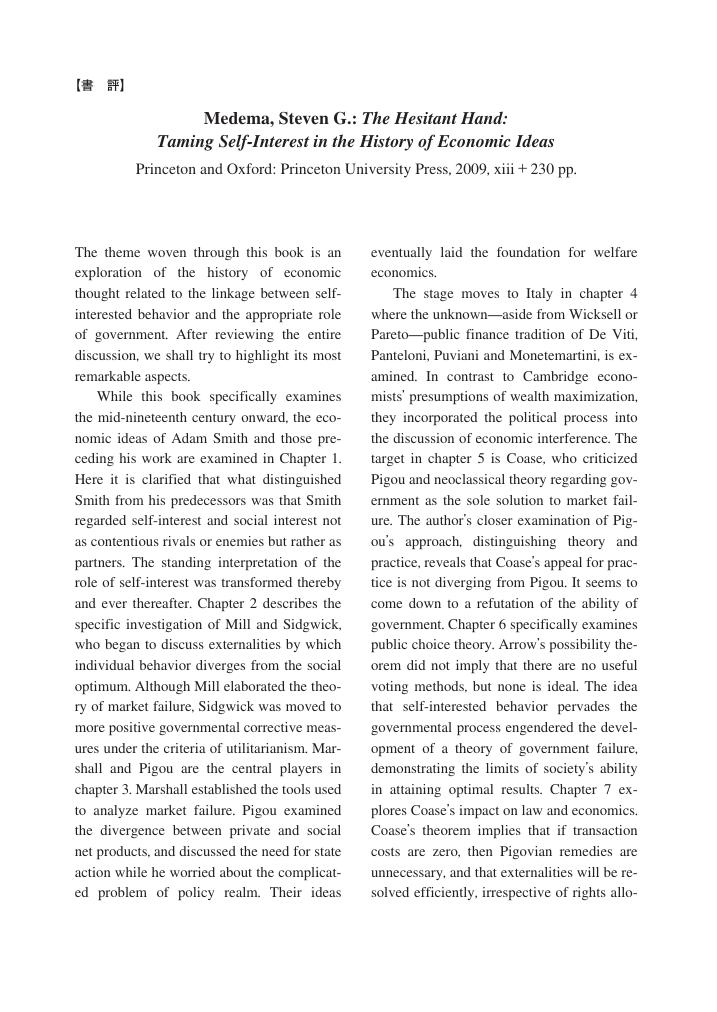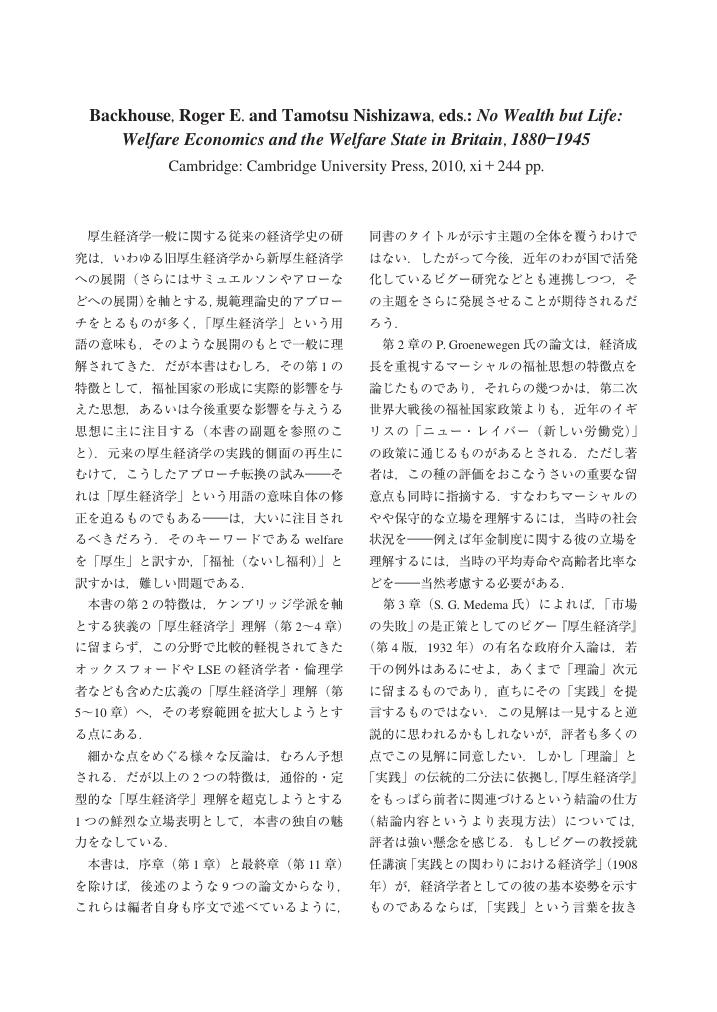- 著者
- 若森 みどり
- 出版者
- 経済学史学会
- 雑誌
- 経済学史研究 (ISSN:18803164)
- 巻号頁・発行日
- vol.54, no.2, pp.83-85, 2013 (Released:2019-10-31)
- 著者
- 池田 幸弘
- 出版者
- 経済学史学会
- 雑誌
- 経済学史研究 (ISSN:18803164)
- 巻号頁・発行日
- vol.54, no.1, pp.122-123, 2012 (Released:2019-10-31)
- 著者
- 古谷 豊
- 出版者
- 経済学史学会
- 雑誌
- 経済学史研究 (ISSN:18803164)
- 巻号頁・発行日
- vol.54, no.1, pp.124-125, 2012 (Released:2019-10-31)
- 著者
- 保住 敏彦
- 出版者
- 経済学史学会
- 雑誌
- 経済学史研究 (ISSN:18803164)
- 巻号頁・発行日
- vol.54, no.1, pp.126-127, 2012 (Released:2019-10-31)
1 0 0 0 OA 楠茂樹『ハイエク主義の「企業の社会的責任」論』勁草書房, 2010年, v+202頁
- 著者
- 吉野 裕介
- 出版者
- 経済学史学会
- 雑誌
- 経済学史研究 (ISSN:18803164)
- 巻号頁・発行日
- vol.54, no.1, pp.128-129, 2012 (Released:2019-10-31)
- 参考文献数
- 2
- 著者
- 藤田 菜々子
- 出版者
- 経済学史学会
- 雑誌
- 経済学史研究 (ISSN:18803164)
- 巻号頁・発行日
- vol.54, no.1, pp.130-131, 2012 (Released:2019-10-31)
1 0 0 0 OA Sugihara Shiro on Kawakami Hajime
- 著者
- 八木 紀一郎
- 出版者
- The Japanease Society for the History of Economic Thought
- 雑誌
- 経済学史研究 (ISSN:18803164)
- 巻号頁・発行日
- vol.54, no.2, pp.1-10, 2013 (Released:2019-08-22)
Abstract: In the last stages of his scholarly life, Sugihara Shiro (1920-2009) wished to collate his lifeʼs research on the history of economic thought in a four-volume work. The ti-tles of these volumes were descriptive of not only his area of research but also his peculiar viewpoint applied in those areas. In the first volume, which is on Marx, Sugi-hara essentially viewed the essence of economy in the “economy of time,” and appre-ciated Marxʼs unique insight of the dialectical relationship between necessary labor time and free disposable time. In the second volume, which is on John Stuart Mill, Sugihara considered Mill to be a sincere inquirer of human freedom, who anticipated the conditions of modern industrial society and mass democracy. The third volume deals with Kawakami Hajime, and the fourth volume, which was unpublished, is his investigation of modern Japanese economic thought using a bibliographical ap-proach. Kawakami Hajime (1879-1946) was a special figure in Sugiharaʼs life. This is because Sugihara grew up in the academia of Kyoto, where Kawakamiʼs influence still remained, and inherited Kawakamiʼs moralistic views. This is seen also in Sugi-haraʼs study of Marx and John Stuart Mill. In this essay, the author critically examines Sugiharaʼs new interpretation of Kawakamiʼs Bimbo Monogatari (Tales on Poverty) and suggests that the adoption of Marxism by Japanese intellectuals occurred under the influence of the Russian Revolution. In the authorʼs view, this historical context overshadows the work of sev-eral generations of Japanese intellectuals, including Sugihara. Kawakamiʼs moralist attitude did not change, even though he became a Marxist, and can be seen in his re-flections on religious truth and scientific truth during his prison years. When Sugi-hara called Kawakami a “Man on Voyage,” he seemed to be expressing his sympathy toward Kawakamiʼs quest for truth in the difficult years of the twentieth century. JEL classification numbers: B 14, B 51, N 35.
1 0 0 0 OA ルーカスの始原から マクロ合理的期待モデルの誕生と屈折するシカゴ
- 著者
- 山崎 好裕
- 出版者
- 経済学史学会
- 雑誌
- 経済学史研究 (ISSN:18803164)
- 巻号頁・発行日
- vol.54, no.2, pp.11-29, 2012 (Released:2019-08-22)
This paper focuses on three papers by Lucas in his early career as a macroeconomist. Consider-ing Lucas and Rapping (1969), Lucas and Pres-cott (1970), and Lucas (1972) successively, we found that Lucasʼs first macro rational expecta-tion model was built combining his macroeco-nomic interest in labor supply and smart mathe-matical techniques to treat a stochastic process and probability. The former had arisen through research from a Keynesian perspective. The latter was the result of research on the investment function, which was parallel to Tobinʼs q theory. We can therefore conclude that Lucasʼs econom-ics was born in a more Keynesian context than has ever been thought. This historical aspect has been virtually neglected by those who thought much of ideological slogans of the macro ration-al expectation school. Lucas (1972), which pro-vided the first macro rational expectation model, was too complicated in terms of structure. Be-sides its very structure, however, it is more important to point out that Lucas introduced to modern macroeconomic theory the concept that stochastic shocks are the main causal factors of economic fluctuations. This revived the lost leg-acy in the early history of econometric research. Lucasʼs economics turns out to have a very interesting feature from this point of view. Though it always retains general equilibrium as the reference axis, it tends to escape from the equilibrium strongly determined by the excess power of the economy. When Lucas built an endogenous growth model, he added an external effect term to Uzawaʼs production function. Such a com-pound feature of Lucasʼs economics made the Chicago school more comprehensive and truly the mainstream of contemporary macroeconom-ics. JEL classification numbers: B 22, E 13.
1 0 0 0 OA カンティロンの「利潤」概念 スミス以後の貧困問題を中心に
- 著者
- 金子 創
- 出版者
- 経済学史学会
- 雑誌
- 経済学史研究 (ISSN:18803164)
- 巻号頁・発行日
- vol.54, no.1, pp.82-99, 2012 (Released:2019-08-22)
The purpose of this article is to reinterpret Rich-ard Cantillonʼs concept of “profit” described in his Essai sur la nature du commerce en général (1755). It examines the conceptual relation between profit and Cantillonʼs two notions “intrin-sic value” and “entrepreneur.” By examining Prendergastʼs (1991) two possible interpretations of the relation of profit with the intrinsic value of a commodity and Brewerʼs (1992) discussion of entrepreneursʼ credit-worthiness, it is shown that Cantillonʼs profit interpreted by Prendergast is constructed of certain and uncertain parts. Certain part of the profit accruing to a commodity producer is the difference between the producerʼs labor value and subsistence level, and uncertain part, which characterizes the producer as an entrepreneur, is the balance between the sales price and the in-trinsic value of a commodity. This construction enables us to interpret Cantillonʼs profit with reference to entrepre-neursʼ labor value and to provide restrictive defi-nitions of Cantillonʼs notions of intrinsic value and entrepreneur. These restrictive definitions, which take into consideration the idea of long-run equilibrium price, indicate that Cantillonʼs notions of intrin-sic value and entrepreneur differ from Adam Smithʼs versions of “natural price” and “employ-er,” respectively. It is shown that the state where-in the price of each commodity equalizes with its intrinsic value and the existence of an entre-preneur receiving uncertain profit are conceptu-ally incompatible in economies in Cantillonʼs ar-gument. Our interpretations represent an explanation for the conceptual change of profit from Cantil-lon to Smith. JEL classification numbers: B11, B31.
1 0 0 0 OA More Ambitious than Might Be Expected:
- 著者
- 佐藤 有史
- 出版者
- The Japanease Society for the History of Economic Thought
- 雑誌
- 経済学史研究 (ISSN:18803164)
- 巻号頁・発行日
- vol.54, no.1, pp.102-105, 2012 (Released:2019-08-22)
1 0 0 0 OA 新村聡氏の書評に答える
- 著者
- 星野 彰男
- 出版者
- 経済学史学会
- 雑誌
- 経済学史研究 (ISSN:18803164)
- 巻号頁・発行日
- vol.54, no.1, pp.106-107, 2012 (Released:2019-08-22)
- 著者
- 中井 大介
- 出版者
- The Japanease Society for the History of Economic Thought
- 雑誌
- 経済学史研究 (ISSN:18803164)
- 巻号頁・発行日
- vol.54, no.1, pp.110-111, 2012 (Released:2019-10-31)
- 著者
- 本郷 亮
- 出版者
- 経済学史学会
- 雑誌
- 経済学史研究 (ISSN:18803164)
- 巻号頁・発行日
- vol.54, no.1, pp.112-113, 2012 (Released:2019-10-31)
- 著者
- 松井 名津
- 出版者
- 経済学史学会
- 雑誌
- 経済学史研究 (ISSN:18803164)
- 巻号頁・発行日
- vol.54, no.1, pp.114-115, 2012 (Released:2019-10-31)
- 著者
- 佐藤 方宣
- 出版者
- 経済学史学会
- 雑誌
- 経済学史研究 (ISSN:18803164)
- 巻号頁・発行日
- vol.54, no.1, pp.116-117, 2012 (Released:2019-10-31)
- 著者
- 壽里 竜
- 出版者
- 経済学史学会
- 雑誌
- 経済学史研究 (ISSN:18803164)
- 巻号頁・発行日
- vol.54, no.1, pp.118-119, 2012 (Released:2019-10-31)
- 著者
- 加藤 健
- 出版者
- 経済学史学会
- 雑誌
- 経済学史研究 (ISSN:18803164)
- 巻号頁・発行日
- vol.54, no.1, pp.120-121, 2012 (Released:2019-10-31)
- 著者
- 高見 典和
- 出版者
- 経済学史学会
- 雑誌
- 経済学史研究 (ISSN:18803164)
- 巻号頁・発行日
- vol.53, no.2, pp.130-132, 2012 (Released:2019-10-31)
- 参考文献数
- 2
1 0 0 0 OA 和田重司『資本主義観の経済思想史』中央大学出版部, 2010年, vii+338頁
- 著者
- 中澤 信彦
- 出版者
- 経済学史学会
- 雑誌
- 経済学史研究 (ISSN:18803164)
- 巻号頁・発行日
- vol.53, no.2, pp.133-134, 2012 (Released:2019-10-31)
- 著者
- 服部 正治
- 出版者
- The Japanease Society for the History of Economic Thought
- 雑誌
- 経済学史研究 (ISSN:18803164)
- 巻号頁・発行日
- vol.54, no.1, pp.1-21, 2012 (Released:2019-08-22)
Abstract: This paper explores the core of the late Noboru Kobayashiʼs scholarship on the histo-ry of economic thought. Kobayashiʼs main research topics are British mercantilism, Adam Smith and Friedlich List. For him, these topics are not independent subjects, but integrated into a single theme. By examining the national and historical charac-ters of Britainʼs and Germanyʼs economics, he tried to elucidate the structures of their economies from the viewpoint of the generation of modern productive powers. He called the unique methodology of his study the “heuristic reciprocation between the history of economic thought and economic history.” Kobayashi clarified that Smithʼs misunderstanding of mercantilism caused a basic defect in his historical recognition of the formation of British capitalism, and that the foundation to Listʼs criticism of Smith arose from this defect. The idiosyncratic points of Kobayashiʼs study are as follows. First, from the view-point of the developing stages of economic theory, Steuartʼs Principles and Smithʼs Wealth of Nations are defined as a general theory of primitive accumulation and a system of capitalist accumulation, respectively. Second, a common feature among the above two works is the economics of affluence, and Steuartʼs Principles can be de-fined as the first system of political economy. Third, Tuckerʼs gradual shift toward economic liberalism coexisted with his consistent political conservatism. Fourth, Listʼs relatively neglected work, Land System, is the key to understanding his social science. He proposed expansionistic policies toward Hungary and the Balkans to cre-ate middle-scale farms as a domestic market for the protected industrial power. In his later years, worrying about the fact that postwar Japan “has amassed an enor-mous GNP at the cost of balance in its economy,” Kobayashi expressed the need for a reflection on contemporary economics that originated with Smith. JEL classifications numbers: B 12, B 15, B 31.















